AEG-Electrolux SANTO 75438 KG User Manual
SANTO 75438 KG
User manual |
Fridge-Freezer |
Manual de instruções |
Combinado |
Gebrauchsanweisung |
Kühl-Gefrierkombination |

Dear Customer
Thank you for choosing one of our high-quality products.
With this appliance you will experience the perfect combination of functional design and cutting edge technology.
Convince yourself that our appliances are engineered to deliver the best performance and control - indeed we are setting the highest standards of excellence.
In addition to this you find environmental and energy saving aspects as an integral part of our products.
To ensure optimal and regular performance of your appliance please read this instruction manual carefully. It will enable you to navigate all processes perfectly and most efficiently.
To refer to this manual any time you need to, we recommend you to keep it in a safe place. And please pass it to any future owner of the appliance.
We wish you much joy with your new appliance.
The following symbols are used in this manual
Important information concerning your personal safety and information on how to avoid damaging the appliance
 General information and tips
General information and tips
 Environmental information
Environmental information
2

Contents
Safety . . . . . . . . . . . . . . . . . . . . . . . . . . . . . . . . . . . . . . . . . . . . . . . . . .4
Disposal . . . . . . . . . . . . . . . . . . . . . . . . . . . . . . . . . . . . . . . . . . . . . . . .5
Appliance Packaging Information . . . . . . . . . . . . . . . . . . . . . . . . . . . . . . .5 Disposal of old Appliances . . . . . . . . . . . . . . . . . . . . . . . . . . . . . . . . . . . . .6
Remove transport safeguard . . . . . . . . . . . . . . . . . . . . . . . . . . . . . . . .6
Installation . . . . . . . . . . . . . . . . . . . . . . . . . . . . . . . . . . . . . . . . . . . . . .6
Installation Location . . . . . . . . . . . . . . . . . . . . . . . . . . . . . . . . . . . . . . . . . .6 Your appliance needs air . . . . . . . . . . . . . . . . . . . . . . . . . . . . . . . . . . . . . .7 Rear spacers . . . . . . . . . . . . . . . . . . . . . . . . . . . . . . . . . . . . . . . . . . . . . . . . .7 Rehingeing the door . . . . . . . . . . . . . . . . . . . . . . . . . . . . . . . . . . . . . . . . . .8
Electrical Connection . . . . . . . . . . . . . . . . . . . . . . . . . . . . . . . . . . . . |
. .8 |
Prior to Initial Start–Up . . . . . . . . . . . . . . . . . . . . . . . . . . . . . . . . . . |
.8 |
Control panel . . . . . . . . . . . . . . . . . . . . . . . . . . . . . . . . . . . . . . . . . . . |
.9 |
Temperature warning . . . . . . . . . . . . . . . . . . . . . . . . . . . . . . . . . . . . |
17 |
Function Errors . . . . . . . . . . . . . . . . . . . . . . . . . . . . . . . . . . . . . . . . . |
17 |
Interior Accessories . . . . . . . . . . . . . . . . . . . . . . . . . . . . . . . . . . . . . . |
18 |
Storage shelves . . . . . . . . . . . . . . . . . . . . . . . . . . . . . . . . . . . . . . . . . . . . |
18 |
Variable Inner Door . . . . . . . . . . . . . . . . . . . . . . . . . . . . . . . . . . . . . . . . . . |
18 |
Bottle holder . . . . . . . . . . . . . . . . . . . . . . . . . . . . . . . . . . . . . . . . . . . . . . . |
18 |
Moisture regulator . . . . . . . . . . . . . . . . . . . . . . . . . . . . . . . . . . . . . . . . . . |
19 |
Drawer . . . . . . . . . . . . . . . . . . . . . . . . . . . . . . . . . . . . . . . . . . . . . . . . . . . . |
19 |
Air recycling . . . . . . . . . . . . . . . . . . . . . . . . . . . . . . . . . . . . . . . . . . . . . . . . |
20 |
Fresh food refrigeration . . . . . . . . . . . . . . . . . . . . . . . . . . . . . . . . . .20 Freezing and storing frozen food . . . . . . . . . . . . . . . . . . . . . . . . . . .21 Preparation of Ice Cubes . . . . . . . . . . . . . . . . . . . . . . . . . . . . . . . . . .22 Freezing Calender . . . . . . . . . . . . . . . . . . . . . . . . . . . . . . . . . . . . . . .22 Installation of the charcoal filter . . . . . . . . . . . . . . . . . . . . . . . . . . .23 Changing the charcoal filter . . . . . . . . . . . . . . . . . . . . . . . . . . . . . . .23 Defrosting . . . . . . . . . . . . . . . . . . . . . . . . . . . . . . . . . . . . . . . . . . . . .24 Switching off the appliance . . . . . . . . . . . . . . . . . . . . . . . . . . . . . . .24 Cleaning and Care . . . . . . . . . . . . . . . . . . . . . . . . . . . . . . . . . . . . . . .25 Energy Saving Tips . . . . . . . . . . . . . . . . . . . . . . . . . . . . . . . . . . . . . . .26
What to do if . . . . . . . . . . . . . . . . . . . . . . . . . . . . . . . . . . . . . . . . . . .26
Changing the light bulb . . . . . . . . . . . . . . . . . . . . . . . . . . . . . . . . . . . . . .28
Regulations, Standards, Guidelines . . . . . . . . . . . . . . . . . . . . . . . . .28
3

 Safety
Safety
The safety aspects of our appliance comply with accepted technical standards and the German Appliance Safety Law. Nevertheless, we consider it our obligation to make you aware of the following safety information:
Intended use
•The appliance is intended for use in the home. It is suitable for the cooling, freezing and storing of frozen food, as well as for making ice. If the appliance is used for purposes other than those intended or used incorrectly, no liability can be accepted by the manufacturer for any damage that may be caused.
•Alterations or changes to the appliance are not permitted for reasons of safety.
•If you use the appliance in a commercial application or forpurposes other than the cooling, freezing or frozen storage of foods,please observe all valid legal regulations for your application.
Prior to initial start–up
• Check the appliance for transport damage. Under no circumstance should a damaged appliance be plugged in! In the event of damage, please contact the vendor.
Refrigerant
The refrigerant isobutane (R600a) is contained within the refrigerant circuit of the appliance, a natural gas with a high level of environmental compatibility, which is nevertheless flammable.
•During transportation and installation of the appliance, be certain that none of the components of the refrigerant circuit become damaged.
•If the refrigerant circuit should become damaged:
–avoid open flames and sources of ignition;
–thoroughly ventilate the room in which the appliance is situated.
Safety of children
•Packaging (e.g. wraps, polystyrene) can be dangerous for children. There is a risk of suffocation! Keep packaging material away from children!
•Please make old appliances unusable prior to disposal. Pull out the mains plug, cut off the mains cable, break or remove spring or boltcatches, if fitted. By doing this you ensure that children cannot lock themselves in the appliance when playing (there is risk of suffocation!)or get themselves into other dangerous situations.
•This appliance is not intended for use by persons (including children) with reduced physical, sensory or mental capabilities, or lack of experience and knowledge, unless they have been given supervision or instruction
4

concerning use of the appliance by a person responsible for their safety. Children should be supervised to ensure that they do not play with the appliance.
Daily Operation
•Containers with flammable gases or liquids can leak at low temperatures. There is a risk of an explosion! Do not store any containers with flammable materials such as, for example, spray cans, fire extinguisher refill cartridges etc in the refrigerator/freezer.
•Bottles and cans must not be placed in the freezer compartment. They can burst when the contents freeze, high carbonate content drinks can even explode! Never store lemonade, juices, beer, wine, sparkling wine etc. in the freezer compartment. Exception: high alcohol content spirits can be stored in the freezer compartment.
•Do not put ice creams or ice cubes in the mouth immediately after removal from the freezer compartment. Very cold ice can freeze to the lips or tongue and cause injury.
•Do not touch frozen food with wet hands. Your hands could freeze to the food.
•Do not operate any electrical appliances in the refrigerator/freezer (e.g. electric ice cream makers, mixers etc.).
•Before cleaning the appliance, always switch off the appliance and unplug it, or pull the house fuse or switch off the circuit breaker.
•When unplugging always pull the plug from the mains socket, do not pull on the cable.
In case of malfunction
•If the a malfunction occurs on the appliance, please look first in the "What to do if ..." section of these instructions. If the information given there does not help, please do not perform any further repairs yourself.
•Applianeces may only be repaired by qualified service engineers. Improper repairs can give rise to significant hazards. If your appliance needs repairing, please contact your specialist dealer or our Customer Service.
Disposal
Appliance Packaging Information
All materials are environmentally sound! They can be dumped or burned at an incinerating plant without danger!
About the materials: The plastics can be recycled and are identified as follows:
>PE< for polyethylene, e.g. the outer covering and the bags in the interior.
>PS< for polystyrene foam, e.g. the pads, which are all free of
chlorofluorocarbon.
5

The carton parts are made from recycled paper and should be disposed of at a waste-paper recycling collection location.
Disposal of old Appliances
For environmental reasons, refrigeration appliances must be disposed of properly. This applies to your old appliance, and - at the end of its service life - for your new appliance as well.
Warning! Before disposing of old appliances make them inoperable. Remove plug from mains, sever the power cable, remove or destroy any snap or latch closures. This eliminates the danger that playing children lock themselves into the appliance (danger of suffocation!) or place themselves into other life-endangering situations.
Disposal:
•The appliance may not be disposed of with domestic waste or bulky refuse.
•The refrigerant circuit, especially the heat exchanger at the back of the appliance, may not be damaged.
•The symbol  on the product or on its packaging indicates that this product may not be treated as household waste. Instead it shall be handed over to the applicable collection point for the recycling of electrical and electronic equipment. By ensuring this product is disposed of correctly, you will help prevent potential negative consequences for the environment and human health, which could otherwise be caused by inappropriate waste handling of this product. For more detailed information about recycling of this product, please contact your local city office, your household waste disposal service or the shop where you purchased the product.
on the product or on its packaging indicates that this product may not be treated as household waste. Instead it shall be handed over to the applicable collection point for the recycling of electrical and electronic equipment. By ensuring this product is disposed of correctly, you will help prevent potential negative consequences for the environment and human health, which could otherwise be caused by inappropriate waste handling of this product. For more detailed information about recycling of this product, please contact your local city office, your household waste disposal service or the shop where you purchased the product.
Remove transport safeguard
The appliance and the interior fittings are protected for transport.
•Remove all adhesive tape and packing pieces from the interior of the appliance.
Installation
Installation Location
The appliance should be set up in a well ventilated, dry room.
Energy use is affected by the ambient temperature. The appliance should therefore
–not be exposed to direct sunlight;
–not be installed next to radiators, cookers or other sources of heat;
–only be installed at a location whose ambient temperature corresponds to the climate classification, for which the appliance is designed.
6
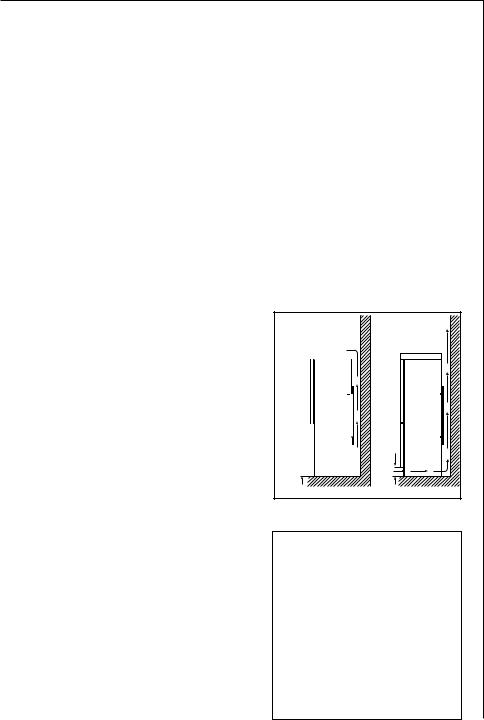
The climate classification can be found on the serial plate, which is located at the left on the inside of the appliance.
The following table shows which ambient temperature is correct for each climate classification: each climate classification:
If installation next to a source of heat is unavoidable, the following minimum clearances must be maintained at the sides of the appliance:
Climate classification |
|
for an ambient temperature of |
|
|
|
|
|
|
SN |
|
+10 bis +32 °C |
|
|
|
N |
|
+16 bis +32 °C |
|
|
|
ST |
|
+18 bis +38 °C |
|
|
|
T |
|
+18 bis +43 °C |
|
|
|
–for electric cookers 3 cm;
–for oil and coal fired ranges 30 cm.
If these clearances cannot be maintained a heat insulating pad is required between the cooker and the refrigeration appliance.
If the refrigeration appliance is installed next to another refrigerator or freezer a clearance of 5 cm at the sides is required, in order to prevent the formation of condensation on the outside of the appliance.
Your appliance needs air
For safety reasons, minimum ventilation must be as shown Fig.
Attention: keep ventilation openings clear of obstruction.
Rear spacers
Inside the appliance you find two spacers which must be fitted.
Slacken the screws and insert the spacer under the screw head, then re-tighten the screws.
mm100




A 

 mm15
mm15 



B |
15 mm |
NP008
7

Door Reversibility
The door reversibility is not possible.
Electrical connection
Before initial start-up, refer to the appliance rating plate to ascertain if supply voltage and current values correspond with those of the mains at the installation location.
e.g.: |
AC |
220 ... |
240 V |
50 Hz or |
|
220 ... |
240 V~ |
50 Hz |
|
(i.e. 220 to 240 volts alternating current, 50 Hertz) The rating plate is inside the appliance on the left.
A correctly installed, earthed socket is required for the electrical supply. The supply must have a fuse rating of at least 10 Amps.
If the socket is not accessible once the appliance is built in, the electrical installation must include suitable means of isolating the appliance from the mains (e.g. fuse, cut-out, current trip or similar with a minimum contact separation of 3 mm).
Attention: The mains connection cable may only be replaced by a skilled electrician. Please contact your dealer or our customer service department for repairs.
Prior to Initial Start–Up
•Please clean the appliance interior and all accessories prior to initial startup (see section: “Cleaning and Care”).
8
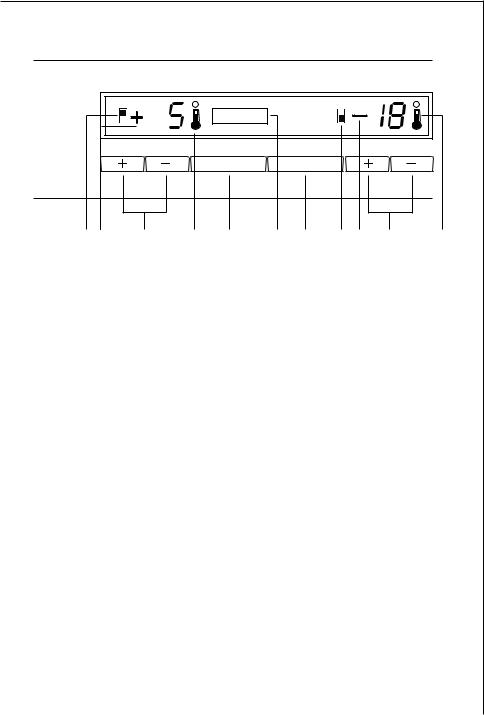
Control panel
|
|
MODE |
|
RESET |
|
|
A B |
C |
D E |
F |
G H I |
L |
M |
A Fridge section indicator
B Temperature indicator for fridge section
C Buttons for setting temperature for fridge section
D Thermometer indicator for fridge section (with COOLMATIC) E MODE button for setting the operating mode
F Text display G RESET button
H Freezer section indicator
I Temperature indicator for freezer section
L Buttons for setting temperature for freezer section
M Thermometer indicator for freezer section (with FROSTMATIC)
Temperature setting buttons
The temperature is adjusted using the „+“ (WARMER) and „-“ (COLDER) buttons.
These buttons are connected to the temperature display.
•The temperature display is switched over from the display of the ACTUAL temperature (Temperature display is illuminated) to the display of the DESIRED temperature (Temperature display flashes) by pressing one of the two buttons, „+“ (WARMER) or „-“ (COLDER).
•Each time one of the two buttons is pressed again the DESIRED temperature is adjusted by 1 °C.
•If neither button is pressed, the temperature display automatically switches back after a short period (approx. 5 sec.) to the display of the ACTUAL temperature.
9

DESIRED temperature means:
The temperature that has been selected for inside the fridge or the freezer compartment. The DESIRED temperature is indicated by flashing numbers.
ACTUAL temperature means:
The temperature display indicates the current temperature inside the fridge or the freezer compartment. The ACTUAL temperature is indicated with illuminated numbers.
Temperature Displays
The temperature displays shows several types of information.
•In normal operation the average temperature in the fridge section is displayed (ACTUAL temperature). The variations in temperature in the whole fridge section are small.
•In the freezer section the warmest temperature is displayed (ACTUAL temperature). When fully filled, the warmest zone is normally located at the top in the front area of the freezer section. Depending upon how the section is filled, the temperatures are lower in other areas of the freezer section.
•When the temperature is being adjusted a flashing display indicates the fridge or the freezer compartment temperature currently set (DESIRED temperature).
Tip: When changing the temperature setting wait about 24 hours until the temperature display has stabilised.
•When there is a temperature warning for the freezer compartment, if the RESET button is activated, the temperature display will show for 5 seconds the warmest temperature the frozen food has reached.
•If there is a fault in the appliance the temperature display shows:
–a square or a letter in the temperature display of the fridge for a fault in the fridge,
–a square or a letter in the temperature display of the freezer for a fault in the freezer.
MODE button
Different operating modes can be set using the MODE button. The following operating modes can be selected:
–SHOPPING: Fridge temperature value 2 °C for 6 hours, cooling for freezer section runs for 1 hour in continuous operation.
–FROSTMATIC: Cooling for the freezer section runs for 52 hours in continuous operation.
–COOLMATIC: Fridge temperature value 2 °C for 6 hours.
10

– FROSTMATIC and COOLMATIC:
Cooling for freezer section runs for 52 hours in continuous operation, fridge temperature value 2 °C for 6 hours.
–HOLIDAY: Fridge temperature value approx 14 °C.
–: Normal operation according to the required temperatures set.
1.Press MODE button once. In the display the operating mode SHOPPING will flash.
2.After approx. 4 seconds the display stops flashing, the operating mode SHOPPING is set.
3.If another operating mode is to be set, before 4 seconds have elapsed, press the MODE button repeatedly until the desired mode is shown in the display. After approx. 4 seconds have elapsed, the display stops flashing, the operating mode is set. If the MODE button is pressed again, the next operating mode appears in the display.
To return to normal operation, press the MODE button repeatedly until no words appear in the display (“ ”).
Text display
The names of the various operating modes that can be set with the MODE button and the words indicating an alarm, power cut or electrical fault appear in the text display.
•Operating modes: SHOPPING, FROSTMATIC, COOLMATIC, FROSTMATIC and COOLMATIC, HOLIDAY, empty field when operating normally.
•Alarm: TEMPERATURE when there is a temperature warning
•After power cut: POWER displayed
•Electrical fault: SERVICE displayed
RESET button
With the RESET button, the acoustic warning signal can be switched off
When there is a temperature warning for the freezer compartment, if the RESET button is activated, the temperature display will show for 5 seconds the warmest temperature the frozen food has reached.
11

Prior to Initial Start-Up
Before connecting the appliance to the mains and putting it into ope-ration for the first time, leave the appliance to stand for 30 minutes if was transported upright. After transport on its side, the appliance must be left to stand for 2 hours before putting it into operation. This is necessary to allow the oil to flow back into the compressor. Otherwise the compressor may be damaged.
1.Please clean the appliance interior and all accessories prior to initial startup (see section: "Maintenance and Cleaning").
2.The appliance must be correctly installed in accordance with the chapter
"Installation" before it is put into operation for the first time. Care should be especially taken that the mains voltage and frequency available correspond with the appliance’s rating plate.
Initial Start-Up
1.Insert plug into mains socket.
2.The temperature indicator and the back lighting light up, the appliance starts up. An alarm sounds, TEMPERATURE appears in the display and the back lighting flashes in red.
3.Switch off alarm and red back lighting using RESET button. The TEMPERATURE indicator goes out, if the temperature in the appliance has gone below the warning temperature.
3 Temperature settings set in the factory: +5 °C for the fridge section, -18 °C for the freezer section.
4. Set the refrigerator to the desired temperature (see section: "Temperature Adjustment").
Goods to be refrigerated can be loaded shortly after switching on, because the storage temperature in the refrigerator is quickly reached.
5. Set the freezer temperature to -18 °C or colder (see section: "Temperature Adjustment").
Do not load freezer with goods until a temperature of -18 °C has been reached, or until the red warning indicator light has gone out..
12

Temperature Adjustment
With the individual temperature setting buttons the desired temperatures in the refrigerator and in the freezer compartment can be adjusted independently of one another.
1. Press either the „+“ (WARMER) or „-“ (COLDER) button for the refrigerator or freezer compartment .
The temperature display switches over and the DESIRED temperature currently set flashes on the temperature display.
2. To adjust to a warmer temperature, press the „+“ (WARMER) button. To adjust to a colder temperature, press the „-“ (COLDER) button. The changed setting is immediately displayed on the temperature display.
Each time the button is pressed the temperature is adjusted by 1 °C. |
|
Adjustable temperature range for the freezer compartment: |
|
-15 °C to -24 °C. |
|
Adjustable temperature range for the refrigerator compartment: |
|
+2 °C to +8 °C, (HOLIDAY: +14 °C ) |
|
Note: +5 °C for the refrigerator compartment and -18 °C for the freezer |
|
compartment should be considered cold enough as a storage temperature. |
|
3. When the buttons are not further pressed after an adjustment has been |
|
made, after a short period (approx. 5 sec.) the temperature display switches |
|
over and again displays the ACTUAL temperature in the refrigerator |
|
compartment. The display changes from flashing to illuminated numbers. |
|
When the setting is changed, the compressor does not start immediately if |
|
automatic defrosting is currently taking place. |
|
The display lighting switches itself on when any button is touched. If no |
|
button is pressed, the display lighting switches itself off after approx. 1 |
|
minute. |
|
Important! Please check regularly on the warning display and on the |
|
temperature display that the storage temperature is being maintained. |
|
Tip: |
|
The appliance setting cannot be changed when the mains plug is pulled out |
|
or there is no power supply. |
|
When reconnected to the mains supply, the appliance takes on the state it |
|
had at the time of the interruption to the power supply. |
|
Important |
|
If the door remains ajar for a long while, the internal lighting will turn |
|
off automatically; after this, the lighting function will be reset |
|
automatically by closing the door and by falling the temperature of |
|
the lamp. |
13 |

Operating modes
Using the MODE button different operating modes can be selected. The operating modes are automatically switched off after a corresponding period, but can also be manualled ended each time. To do this, press the MODE button repeatedly until there are no longer any words appearing in the display. After the operating modes have been completed, the appliance continues to run with the previously set desired temperatures.
As long as the figures in the temperature display are still flashing after the desired temperature has been set, no operating mode can be set with the MODE button.
SHOPPING
The SHOPPING function is suitable for quickly cooling larger quantities of refrigerated foods in the fridge section, as well as for smaller amounts of frozen foods in the freezer section, e. g. after a big shop.
This automatically sets a desired temperature of +2 °C for the fridge section for 6 hours. Cooling for the freezer section runs for 1 hour in continuous operation.
1. Press the MODE button repeatedly until SHOPPING is flashing in the display.
After approx. 4 seconds the operating mode SHOPPING is activated, the SHOPPING indicator lights up. Both thermometer indicators in the display show a falling temperature column.
The SHOPPING function is automatically switched off after 6 hours. The SHOPPING indicator will go out.
The display lighting switches itself on when any button is touched. If no button is pressed, the display lighting switches itself off after approx. 1 minute.
FROSTMATIC
The FROSTMATIC function provides for quick freezing of fresh food products, and at the same time protects previously stored goods against undesired warming in the freezer compartment.
The cooling of the freezer section runs for about 52 hours in continuous operation.
1. Press the MODE button repeatedly until FROSTMATIC is flashing in the display.
After approx. 4 seconds the operating mode FROSTMATIC is activated, the FROSTMATIC indicator lights up. The thermometer indicator in the display for the freezer section shows a falling temperature column.
14

The operating mode FROSTMATIC is automatically switched off depending on how the appliance is filled at the latest after approx. 52 hours. The FROSTMATIC indicator will go out.
COOLMATIC
The COOLMATIC operating mode is suitable for quickly cooling larger quantities of refrigerated foods in the fridge section, e. g. drinks, salads for a party or wedding.
1. Press the MODE button repeatedly until COOLMATIC is flashing in the display.
After approx. 4 seconds the operating mode COOLMATIC is activated, the COOLMATIC indicator lights up. The thermometer indicator in the display for the fridge section shows a falling temperature column.
The COOLMATIC function now provides for intensive cooling. A DESIRED temperature of +2 °C is automatically selected. The COOLMATIC function is ended automatically after a period of 6 hours. The originally selected DESIRED temperature is again valid. The temperature display shows the ACTUAL refrigerator temperature.
FROSTMATIC and COOLMATIC
When the FROSTMATIC and COOLMATIC functions are combined, a desired temperature of +2 °C is automatically set for the fridge section for 6 hours. Cooling for the freezer section runs for 52 hours in continuous operation.
1. Press the MODE button repeatedly until FROSTMATIC and COOLMATIC are flashing in the display at the same time.
After approx. 4 seconds the operating mode FROSTMATIC and COOLMATIC is activated, the FROSTMATIC und COOLMATIC indicators light up. Both thermometer indicators in the display show a falling temperature column.
The function FROSTMATIC and COOLMATIC is automatically switched off: COOLMATIC after 6 hours, FROSTMATIC after 52 hours at the latest.
The indicators go out accordingly.
HOLIDAY
In the operating mode HOLIDAY (holiday setting) the desired temperature
value for the fridge section is +14 °C. In the holiday mode it is therefore possible to leave the door of the empty refrigerator closed during periods of extended absence. Advantage: Unintentional closing of the door, or accidental closing of the door by persons who have access to your home during your absence, is no longer possible. Without the holiday mode leaving the door closed would lead to the accumulation of odours and mould.
15

After emptying and cleaning the appliance, proceed as follows:
1. To switch on the holiday setting, press the MODE button repeatedly until HOLIDAY is flashing in the display.
After approx. 4 seconds the operating mode HOLIDAY is activated, HOLIDAY lights up.
Important! Do not store any goods in the refrigerator when the holiday mode is in operation. The temperature is regulated at about +14 °C when the holiday mode is in operation. This is too warm for food products.
Switching the Appliance Off
To switch the entire appliance off, remove the mains plug or switch off. If the appliance is not to be used for an extended period:
1.Remove the mains plug or switch off.
2.Clean the appliance (see section: "Maintenance and Cleaning").
3.Leave the doors open after defrosting to avoid accumulation of odours.
Control and Information Systems
The control and information systems consist of a temperature display, an optical warning indicator light and an acoustic warning.
The system warns:
–when there was a power cut;
–when the temperature in the refrigerator or freezer compartment is too high;
–if there are functional disturbances at the appliance.
Power cut warning
After an interruption to the power supply, POWER is displayed in the display and the current Actual temperature is displayed again. The appliance continues to run with the previously selected settings. The POWER indicator goes out, as soon as any button is pressed.
16

Temperature warning
For the freezer section:
An alarm sounds and the TEMPERATURE indicator and red back light flash, as soon as the temperature in the freezer section rises above -11 °C. In addition the temperature display for the freezer section flashes.
If the temperature in the freezer section falls back below -11 °C, the alarm automatically switches itself off. The TEMPERATURE indicator and the red back lighting continue to flash.
1. You can turn off the alarm and the red back lighting using the RESET button.
For 5 seconds the temperature display for the freezer section shows the warmest temperature that was reached in the freezer section during the temperature warning. After that the temperature display stops flashing and switches back to the current temperature in the freezer section. The TEMPERATURE indicator continues to flash, as long as there is a temperature warning.
If there is an interruption to the power supply during an alarm, when the appliance is reconnected to the supply, it starts with an acoustic and visual alarm.
If the possibility of partial or complete thawing exists, you should check the quality of the foods.
A rise in temperature may be caused by:
–frequent door opening for long periods of time;
–loading with large quantities of warm foods;
–high ambient temperature;
–an error with the appliance.
Function Errors
If the appliance’s electronics recognise a technical problem that has to be remedied by the Customer Service Department, an alarm sounds and the SERVICE indicator appears back lit with a flashing red light.
The temperature display indicates:
–a square or a letter in the temperature display of the fridge for a fault in the fridge,
–a square or a letter in the temperature display of the freezer for a fault in the freezer.
1. Using the RESET button you can switch off the alarm and the flashing red light. The SERVICE indicator continues to be lit as long as there is an electrical malfunction.
17
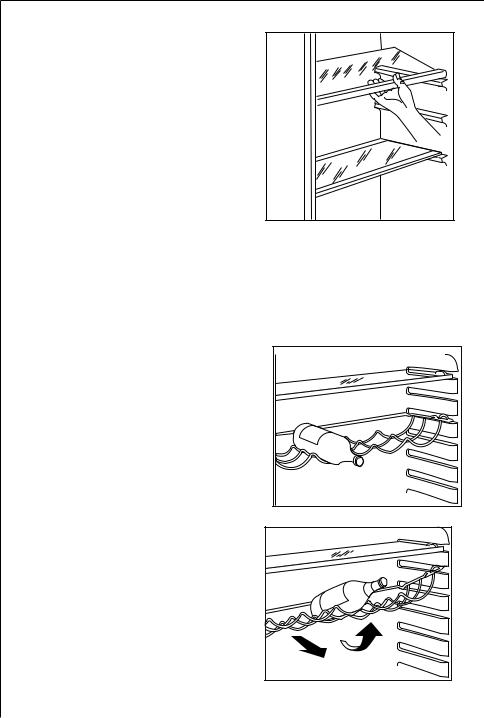
Interior Accessories
Storage Shelves
The glass shelf above the fruit and vegetable compartment should always remain in position, to ensure fruit and vegetables stay fresh longer.
The remaining storage shelves can be adjusted to various heights:
Pull the storage shelf forward until it can be tipped up or down and
removed. To insert at a different D338 height use the same procedure in reverse.
Variable Inner Door
The door compartments can be pulled up and removed, and inserted at other positions as needed.
Bottle holder
Place the bottles (with the opening facing front) in
the prepositioned shelf.
If the shelf is positioned horizontally, place only
closed bottles.
This bottle holder shelf can be tilted in order to store
previously opened bottles.
To obtain this result, pull the shelf up so it can rotate
upwards and be placed on the next higher level.
18
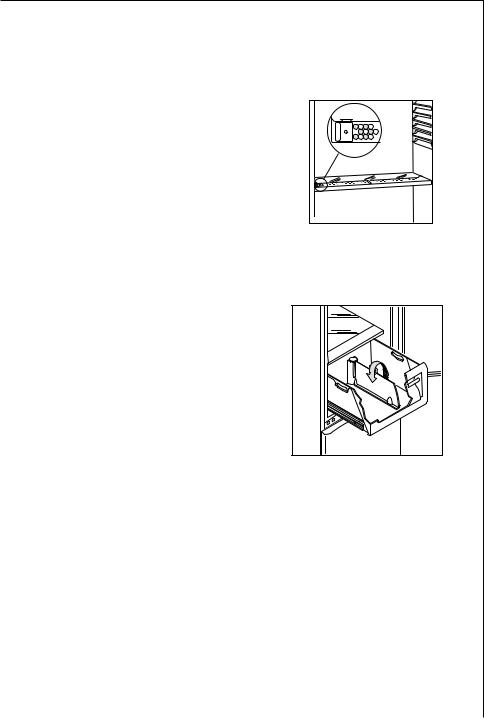
Moisture regulator
There is an adjustable air grille in front of the shelf above the fruit and vegetable compartments. The opening in the ventilation slots can be adjusted with the slider. Right slider: Ventilation slots opened.
With the ventilation slots open, more air circulation results in a lower air moisture content in the fruit and vegetable compartments. Left slider: Ventilation slots closed. When the ventilation slots are closed, the natural moisture content of the food in the fruit and vegetable compartments is preserved for longer.
PR271 |
Drawer
The drawer is suitable for storing fruit and vegetables. There is a separator inside the drawer that
can be placed in different
positions to allow for the subdivision best suited to personal needs.
There is a grille on the bottom of
the drawer to separate the fruit and vegetables from any
humidity that may form on the bottom surface.
To remove the drawer, use the side handles (as shown in the Fig.). All parts inside the drawer can be removed for cleaning purposes.
19

Air recycling
The refrigerator compartment is equipped with a special D.A.C. (Dynamic Air Cooling) fan which can be turned on with the switch B (seefig.).
The green light, when on, means that the fan is working.
It is suggested that the device be used when the ambient temperature exceeds 25°C .
This device allows for rapid cooling of foods and a more uniform temperature in the compartment.
Fresh food refrigeration
To obtain the best performance:
•do not store warm food or evaporating liquide in the refrigeator
•do cover or wrap the food, particularly if it has a strong flavour.
•Position food so that air can circuiate freely round it.
Useful hints:
Meat (all types): wrap in polythene bags and place on the glass shelf above the vegetable drawer(s)For safety, store in this way only one or two days at the most.
Cooked foods, cold dishes, etc: these should be covered and may be placed on any shelf.
Fruit and vegetables: these should be thoroughly cleaned and placed in the special drawer(s) provided.
Butter and cheese: these should be placed in special airtight containers or wapped in aluminium foil or polythene bags to exclude as much air as possible.
Milk bootles: these should have a cap and should be stored in the bottle rack on the door.
Bananas, potatoes, onions and garlic, if not packed, must not be kept in the refrigerator.
20

Freezing and storing frozen food
You can use your freezer for freezing fresh food yourself.
Important!
•The temperature in the freezer compartment must be –18 °C or colder before freezing food.
•Please observe the freezing capacity given on the rating plate. The freezing capacity is the maximum quantity of fresh food that can be frozen within a period of 24 hours. If you wish to freeze food several days in a row, please observe a maximum capacity of only 2/3 to 3/4 of that on the rating plate. The quality of the food is best preserved when it is frozen right through to the core as quickly as possible.
•Allow warm food to cool down before freezing. The warmth will cause increased ice formation and increase the power consumption.
•Please note the maximum storage times specified by the manufacturer.
•Thawed foods which have not been processed further (cooked into meals) may not under any circumstances be frozen a second time.
•Containers with flammable gases or liquids can leak at low temperatures. There is a risk of an explosion! Do not store any containers with flammable materials such as, for example, spray cans, fire extinguisher refill cartridges etc in the refrigerator/freezer.
•Bottles and cans must not be placed in the freezer. They can burst when the contents freeze, high carbonate content drinks can even explode! Never store lemonade, juices, beer, wine, sparkling wine etc. in the freezer. Exception: high alcohol content spirits can be stored in the freezer.
•All foods must be packed air tight prior to freezing, so that they do not dry out or lose their flavour, and so that no flavour contamination of other frozen goods occurs.
•Not open the door frequently or leave it open longer than absolutely necessary.
•Unfrozen food must not touch items already frozen, otherwise the frozen food could begin to defrost.
Caution! Do not touch frozen food with wet hands. Your hands could freeze to the food.
1.Place the food to be frozen on the freezer shelf.
21
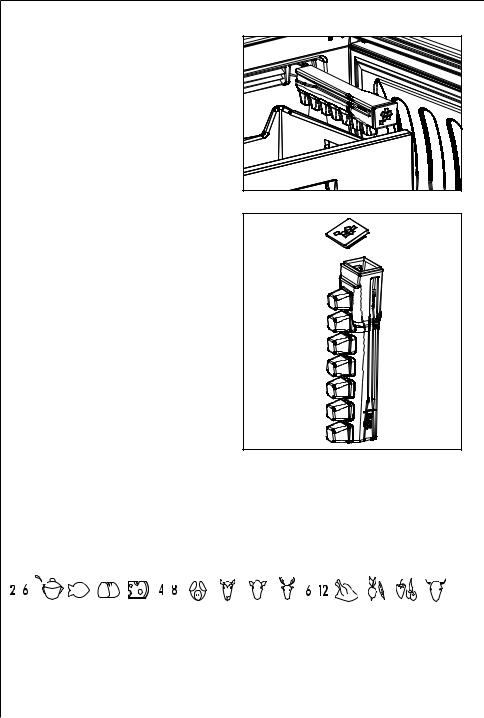
Ice-cube production
This appliance is equipped with one or more trays for the production of ice-cubes.
These are insert on the sides of the upper freezer drawer.
Pull out the upper freezer drawer. Extract the ice-tray.
Pull out the tap.
Fill with water to the limit indicated. “MAX”.
Refit the tap and insert the tray in the appropriate place.
To remove the ice cubes rotate the tray with the ice needles towards the top and hit on a rigid surface.
To semplify the release of the ice needles it is recommended to keep the closed tray under if possible luke warm water for a few seconds.
Do not use metallic instruments to remove the trays from the freezer.
Freezing Calendar
•The symbols show different types of frozen goods.
•The numbers indicate storage times in months for the appropriate types of frozen goods. Whether the upper or lower value of the indicated storage time is valid depends on the quality of the foods and pre-treating before freezing. The lower value applies to foods with high fat content.
22

Installation of the charcoal filter
On delivery the charcoal filter is placed in a plastic bag to secure the length of life of the charcoal filter. The filter should be placed behind the flap before the appliance is turned on.
• Pull the cover outward
• The charcoal filter is then mounted in the slot found in the back of the cover.
• Close the flap.
Important!
During operation, always keep the air ventilation flap closed.
The filter should be handled carefully so fragments do not loosen from the surface.
Changing the charcoal filter
To maintain the best performance the carbon filter should be changed every year.
New charcoal filters can be purchased from your local dealer.
• The filter is placed behind the cover and can be reached by pulling the cover outward .
• The charcoal filter is then pulled out of its slot.
•The new charcoal filter is placed in the existing slot. Close the flap.
Important
The filter should be handled carefully so fragments do not loosen from the surface.
23
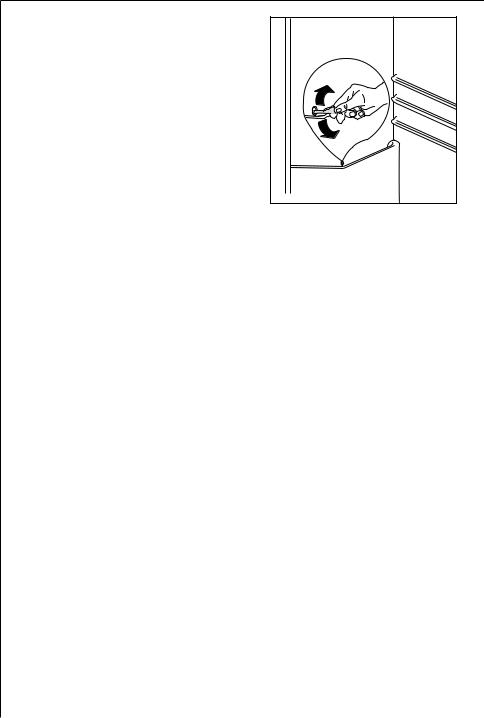
Defrosting
Refrigerator
Frost is automatically eliminated during normal use. The defrost water drains out through a trough into a special container at the back of the appliance, where it evaporates.
We recommend that you peridically clean the defrost-water drainage outlet with the cleaner provided, located in the center of the drainage groove.
D037 |
Freezer
Your appliance is frost free, which means there is no need to manually defrost your appliance as this will be carried out automatically.
Switching off the appliance
To switch off the appliance, turn the temperature regulator to position "0".
If the appliance is not going to be used for an extended period:
1.Remove all refrigerated and deep-frozen packages as well as ice trays.
2.Switch off the appliance .
3.Remove the mains plug or switch off or turn out the circuit breaker or fuse.
4.Defrost freezer compartment and clean thoroughly (see section: “Cleaning and Care”).
5.Leave the door open to avoid the build up of odours.
24

Cleaning and Care
For hygienic reasons the appliance interior, including interior accessories, should be cleaned regularly.
Warning!
•The appliance may not be connected to the mains during cleaning. Danger of electrical shock! Before cleaning switch the appliance offand rem ve the plug from the mains, or switch off or turn out the circuit breaker or fuse.
•Never clean the appliance with a steam cleaner. Moisture could accumulate in electrical components, danger of electrical shock! Hot vapours can lead to the damage of plastic parts.
•The appliance must be dry before it is placed back into service.
Attention!
•Ethereal oils and organic solvents can attack plastic parts, e.g.
– lemon juice or the juice from orange peals;
– butyric acid;
– cleansers which contain acetic acid.
Do not allow such substances to come into contact with appliance parts.
•Do not use any abrasive cleansers.
1.Remove frozen food and the food from the refrigerator. Wrap frozen food in several layers of newspaper. Store it in a cool place, well covered.
2.Defrost the freezer compartment prior to cleaning (see "Defrosting" section).
3.Switch the appliance off and remove the plug from the mains, or switch off or turn out the circuit breaker or fuse.
4.Clean the appliance and the interior accessories with a cloth and lukewarm water. Commercially available dish washing detergents may also be used.
5.After cleaning wipe with fresh water and rub dry.
Accumulation of dust at the condenser increases energy consumption. For this reason carefully clean the condenser at the back of the appliance once a year with a soft brush or a vacuum cleaner.
6.Check the water drain hole on the rear wall of the fridge. Clear a blocked drain hole with the aid of the green peg included with the appliance.
7.After everything is dry place appliance back into service.
25

 Energy Saving Tips
Energy Saving Tips
•Do not install the appliance near cookers, radiators or other sources of warmth. High ambient temperatures cause longer, more frequent operation of the compressor.
•Ensure sufficient air circulation and exhaust at the appliance base and at the back wall of the appliance. Never cover air vent openings.
•Do not place warm foods into the appliance. Allow warm foods to cool first.
•Only leave door open as long as necessary.
•Do not set temperature any colder than necessary.
•Put frozen food in the fridge to defrost. The cold in the frozen food will then be used to cool the fridge.
•Keep the heat emitting condenser, the metall grille on the rear wall of your appliance, always clean.
What to do if ...
Correcting Malfunctions
A malfunction may be caused by only a minor fault that you can rectify yourself using the following instructions. Do not perform any other work on the appliance if the following information does not provide assistance in your specific case.
Warning! Repairs to refrigerators/freezers may only be performed by qualified service engineers. Improper repairs can give rise to significant hazards for the user. If your appliance needs repairing, please contact your specialist dealer or our Customer Service.
26
